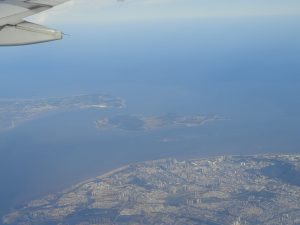The Taiwanese islands of Kinmen are just 3 kilometers away from the People’s Republic of China (PRC). From Kinmen, neon signs and lit-up buildings in the PRC city of Xiamen can be seen at night across the shore, and in the daytime, you are close enough to see PRC residents sunbathing on the beach.
Kinmen, which nominally remains part of Fujian province in the Republic of China, is at the crux of cross-strait tensions. It has been bombed several times by the People’s Liberation Army in the past and was viewed historically by Chiang Kai-shek, the long-time leader of the Republic of China, as a staging post for the recapturing of China. Today, Kinmen is at the forefront of Beijing’s gray zone tactics.
For the Taiwanese residents of Kinmen, the PRC is not an abstract threat but an everyday practical reality. Kinmen welcomes around 250,000 Chinese tourists a year. Many residents have partners from the mainland and are entitled to PRC identity cards, and their children often opt to take the 30-minute ferry to Xiamen to shop and party the night away.
It is therefore not surprising that politically, Kinmen residents support the KMT, which favors closer links with the PRC. In the recent presidential election, the islanders gave 61 percent of their votes to the KMT candidate.
For its part, Beijing has pushed efforts to court Kinmen. Last year, the PRC’s Taiwan Affairs Office proposed the creation of a special economic zone encompassing Xiamen and Kinmen, which would involve the building of a land bridge connecting mainland China and a new offshore airport in Xiamen, and Kinmen.
The proposed bridge is reminiscent of the Hong Kong-Zhuhai-Macau Bridge, which the PRC constructed in October 2018 to bind Hong Kong and Macau closer to the other cities in the Greater Bay Area in Guangdong.
In the recent presidential election in Taiwan, the topic of the bridge was hotly debated, with the KMT’s presidential candidate, New Taipei City Mayor Hou Yu-ih, promising a local referendum on the bridge. Meanwhile, newly elected Taiwanese President Lai Ching-te has blocked its construction on national security grounds.
The Taiwanese government’s concern is driven by the potential weaponization of strategic infrastructure by the PRC to divide Taiwanese society and force the issue of reunification through dependency. As it stands, Kinmen is already dependent on the PRC for 68 percent of its water through the Kinmen-China water pipeline (which was completed in 2018).
This is not the first time that decisions in Taipei have divided opinion on Kinmen. At the beginning of the COVID-19 pandemic, the decision by the Taiwanese government on February 20, 2020, to close its borders and cut the “three links” – which had allowed travel, direct commerce, and mail service between Taiwan and the PRC – received strong support from some of the public on health grounds, but Kinmen’s only legislator initially opposed it on the grounds it would hurt the island’s economy.
More broadly, there appears to be little consensus among Taiwanese society regarding the strategic importance of Kinmen. Views are evenly divided between those who see Kinmen as “the first line of defense” or a “buffer” against the PRC and those who consider Kinmen to have little strategic value other than potentially serving as a future bargaining chip in negotiations.
This division creates a significant opportunity for Beijing to use tools ranging from disinformation to outright political interference to drive a wedge between the people of Kinmen and the government in Taipei. A part of this “gray zone” strategy might include the sowing of a misleading narrative that Lai is actively seeking to cut Kinmen off from Xiamen in the future, which would divide families and hurt the local economy.
As with Russia’s annexation of Crimea, the end goal would be to create chaos and encourage local actors to push publicly for reunification. This would create a smokescreen for the PRC to annex Kinmen in what analysts describe as a “salami slicing” approach.
Kinmen is not explicitly included in the United States’ Taiwan Relations Act, which governs relations between the U.S. and Taiwan after Washington’s recognition of the People’s Republic of China in 1979. However, U.S. special forces were deployed on the island back in the spring of 2024. It is unclear whether the Taiwanese government or its Western allies would be willing to go to war with the PRC over Kinmen, particularly if Beijing did not then push for an invasion of Taiwan’s main island.
In a recent paper for the China Strategic Risks Institute, my colleague Andrew Yeh outlined several “gray zone” scenarios, which include the PRC taking the islands of Kinmen along with Matsu. The paper argued that in Europe, policymakers have focused too narrowly on a full PRC invasion or an embargo of Taiwan while not having adequately considered policy responses to lower-level and equally troubling military escalations in the Taiwan Strait.
Given Vladimir Putin’s playbook in Ukraine started with the annexation of Crimea, Western policymakers need to pay closer attention to Kinmen. They should offer material support to Taiwan to fight disinformation, ensure diplomats and officials visit Kinmen, and help Taiwan build up economic resilience in its outlying islands.
Irrespective of the differing views of Taiwanese people regarding cross-strait relations, Kinmen has strategic value for the international community who concern themselves with peace in the region. According to official PRC historical accounts, Mao Zedong long viewed Kinmen and Matsu as a noose with which to bind Taiwan to mainland China and prevent Taiwan from declaring its independence.
Any attempt by Beijing to annex Kinmen and destabilize the status quo would make the possibility of the PRC invading or embargoing Taiwan even more likely. We need to do a better job of discussing the political fault lines in Kinmen and pre-empting PRC attempts at its annexation.
































